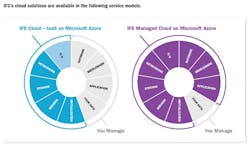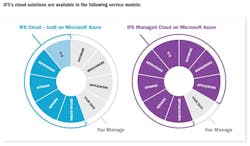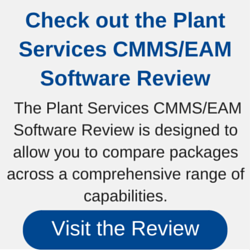Infrastructure hosting options offer new opportunities for EAM deployment
[javascriptSnippet]
Running servers, maintaining software, and optimizing databases are not the first skills that come to mind when thinking of asset-intensive organizations. Their personnel are more concerned with equipment reliability, uptime, safety, and the quality and continuity of their production lines – not the fine details of how to optimize their enterprise information systems.
The original on-premises delivery of enterprise asset management (EAM) software forced customers to reach outside their sweet spot and delve into the details of managing and optimizing information systems. Soon afterward, application hosting alternatives were developed, allowing EAM customers to place greater focus on their core business objectives rather than extraneous IT tasks.
Now, the advent of cloud computing and related technology advancements has led to even more sophisticated EAM software provisioning opportunities. Two new hosting models are improving the total cost of ownership (TCO) by reducing the IT management burden, while also returning a degree of security and control to the customer.
Initial EAM delivery options were lacking
When the EAM class of software was in its infancy, the solution was usually deployed within a data center on the customer’s own property. This required significant investments in software, IT and associated support personnel, but the customer retained total control of both the environment and data in-house.
SaaS should be considered when:
- You prefer low or no upfront software investment
- You wish to outsourcing the technical skills and IT infrastructure necessary to support and maintain the hardware and software
- You can accept the implications of running a shared solution
IaaS should be considered when:
- You wish to reduce the need for on-premises hardware and IT resources, saving time and money
- You want the flexibility of having subscription and/or perpetual software licenses
- You don’t mind missing the advantage of sharing operational costs across tenants
Both IaaS and SaaS should be considered when:
- You want the financial structure that SaaS offers, including lower CapEx for software, hardware, and IT
- You don’t want the restrictions that a multi-tenant, shared solution involves
Over time, hosted deployment models emerged to lessen the customer’s upfront capital expenditures (CapEx) and ongoing software maintenance costs. The initial approach had EAM applications purchased by the customer hosted in remote data centers that were managed by the software vendor or a third party, and accessed by end users from a web browser. This option transferred responsibility for the software, technology, and security away from the customer, yet some sizeable upfront costs were still required.
The next hosting iteration, Software-as-a-Service (SaaS), reduced CapEx even further by avoiding the large, upfront software investment in addition to the IT-related costs. The EAM software is sold on a subscription basis, hosted in a data center operated by the vendor or a third party, and accessed by end users from a web browser.
However, certain downsides to the SaaS approach make it impractical for some companies. Most SaaS applications are multi-tenant environments, meaning that multiple EAM customers share the same software and rely on security mechanisms to keep their data separate from other tenants. The applications are not housed on separate virtual servers. This is a key point of concern for asset- and security-intensive organizations such as aerospace and defense, who find it problematic to operate on a shared version of software.
Furthermore, although the low entry cost for a SaaS EAM solution may be appealing, it is possible that the long-term costs of “renting” the software may be significantly higher than traditional perpetual licensing and maintenance. Also, in SaaS, the vendor controls most maintenance and upgrade decisions and timing, and any usage limitations that may be imposed. Customizations are usually not supported, and integration to other applications, especially legacy applications, can be a challenge. Nevertheless, for some companies, these characteristics are not show-stoppers and SaaS is the ideal delivery model.
Cloud-based hosted infrastructure fills the gaps
New single-tenant options for hosting EAM software in the cloud address the challenges of on-premises, traditional hosted, and multi-tenant SaaS provisioning alternatives. The two new models leverage Infrastructure-as-a-Service (IaaS) strategies:
- IaaS model: The cloud infrastructure is hosted and managed while the applications on it are self-managed.
- IaaS/SaaS model: Both the infrastructure and the applications are hosted and operated as a fully-managed cloud service.
IaaS cloud solution platforms offer agility, flexibility, reliability, and advanced data protection that is compliant with international security and data protection standards. The business continuity features likely surpass any that a typical customer’s on-premises installation would include.
IFS, IBM, and Oracle are among the companies offering IaaS deployment options to their EAM customers as a means to improve security, control, and cost predictability.
For example, IaaS models are currently available with IFS applications such as ERP, EAM, and ESM running on the Microsoft Azure cloud computing environment. IFS Cloud–IaaS for Microsoft Azure allows customers to deploy their own IFS software and database instance on virtual servers in Microsoft Azure instead of in their own data center. The customers may control the application layer themselves or have a partner manage it. It is a single-tenant IaaS offering.
With IFS Managed Cloud for Microsoft Azure, IFS manages the cloud infrastructure, operating system, database, middleware, and IFS products under a single contract, allowing the customer to concentrate on data quality and accuracy. In this full-service, managed IaaS/SaaS offering, the solution is set up in a private environment and virtual network within Azure, while the data is secured in a single-tenant database not shared with others and controlled only by the customer.
IBM enterprise applications such as Maximo Asset Management leverage the IBM Cloud for IaaS, whether the self-managed SoftLayer infrastructure or a fully managed infrastructure cloud environment for enterprise application implementations. SoftLayer’s virtual servers are available on public or private nodes of their public cloud. Multi-tenant or single-tenant, local or SAN storage options are available.
IBM Enterprise Asset Management Fundamentals on Cloud (Maximo) is a fully managed SaaS cloud service hosted on the IBM SoftLayer IaaS. It lets organizations deploy solutions on the cloud without having to build and maintain an IT infrastructure.
"IBM Maximo SaaS utilizes the same code base and function that is available in IBM Maximo Asset Management suite, and incorporates operational technology to support the IT elements of enterprise assets." says Samir Vyas, WW Manufacturing Industry Leader at IBM.
For Oracle eAM, there’s the Oracle Cloud IaaS, which is managed, hosted and supported by Oracle. Oracle Compute Cloud Service offers compute, storage and networking services, and customers can choose from a multi-tenant environment or dedicated single-tenant resources on Oracle Public Cloud. The subscription-based IaaS model offers elastic compute and storage capacity, a separate virtual machine instance, and other benefits of the cloud including lower CapEx and personnel costs.
The IaaS/SaaS offering, Oracle Managed Cloud Services, offers end-to-end application and technology management for Oracle’s solution portfolio, including ERP, eAM, Analytics, BI and other products from Oracle, PeopleSoft, and JD Edwards EnterpriseOne.
The cloud’s appeal is growing
The advantages of the cloud-based IaaS and IaaS/SaaS provisioning models are many and the market is responding.
“Business solutions deployed in the cloud have gained favor over the past several years at the expense of the traditional on-premise deployment model. This is true for midmarket organizations where cloud solutions can provide significant benefits due to their low cost, scalability, flexibility, and ease of use,” says Aberdeen Group research director Nick Castellina in his report, Improve Your Midmarket Business Operations with Cloud Applications (September 2014).
“Since a cloud solution is accessible to employees no matter where they are, it is easier to share the functionality included in the solutions across wider distances and to more users. Ultimately, this improves visibility, impacts collaboration, and enables efficiency and agility,” writes Castellina.
IaaS advantages
“Using an IaaS solution is inherently a single-tenant solution, aside from the sharing of the underlying hardware, which is largely invisible to customers,” says Rick Veague, chief technology officer at IFS North America. “It gives you more flexibility with regard to the software supported, integrations and customizations, and it puts you in control of when you patch and upgrade.”
Unlike a SaaS solution, the licensing of applications for an IaaS deployment is handled separately, in some cases allowing for both a subscription and/or a perpetual license approach, notes Veague.
[sidebar id="5"]
One potential downside of the single-tenant model is in operational costs. In a traditional SaaS model, support and upgrade costs are shared across multiple tenants, but that is not the case with the IaaS approach.
IaaS/SaaS advantages
Using IaaS and SaaS together leverages the economics of the cloud by reducing or eliminating on-premises hardware and IT staff, and instead relying on the EAM vendor’s expertise.
“As applications become ever more technically complex, more and more specialization is required to properly maintain and operate them. However, these specialized skills are often not required on a frequent or full-time basis. Outsourcing this, either via SaaS or IaaS solutions, generally provides access to these resources when needed (and without your involvement), but the cost is shared by many customers,” explains Veague.
The integrated IaaS/SaaS service model is also notable for its on-demand scalability, which eliminates the need for capacity requirements planning. It allows customers to control when their software is upgraded and enables them to apply needed interfaces. The cloud approach provides 24/7 access to their data from any location, and service level agreements (SLA) can be clearly defined.
Relish the successes
Some IFS customers are already realizing the benefits of the new cloud-based deployment models. Examples include:
- Reduction in IT support staff of three FTE (one deferred hire and two redeployments)
- Elimination of the need to acquire or upgrade hardware
- Elimination of several software maintenance contracts
- Rapid IT change due to largely eliminating the provisioning and procurement process associated with adding or changing IT resource requirements
- Substantial cost savings
Be prepared for the challenges
For many customers, particularly those with specific security concerns such as ITAR compliance in the defense trade, a multi-tenant model is simply not feasible. For them, a single-tenant cloud hosted model may be more suitable as it provides cost savings and operational improvements over an on-premises installation but without the limitations or restrictions of a full multi-tenant SaaS solution. For businesses without these concerns, the hosted EAM SaaS model is a viable option.
Ebara, a precision instruments manufacturing company and beta customer for IFS Applications on Microsoft Azure, chose the single-tenant path based on a corporate policy directive. “Ebara has made a company-wide decision to put key IT systems into the cloud. We were more than impressed with the ease and speed of creating our first IFS working environment on Azure,” says Frank Lowery, formerly director of IS at Ebara International Corporation.
There are real as well as perceived challenges to overcome when implementing a cloud-based hosting solution. “From a business sense, it is a different finance model and may involve new partnerships that you will be betting your business on. From a technical perspective, there are real, practical concerns associated with software versions, network connectivity, security, etc., that have to be addressed,” says Veague.
Two perceived concerns frequently come up: software security and job security. “Many people raise concerns about how secure your applications and data are in the cloud, and rightly so. But the reality is that security risks exist on premises as well,” remarks Veague. “The real question is, can your own organization match the level of investment in skills, technology, and resources that cloud providers are making? In many cases, the answer is no, and the cloud is actually more secure than an on-premises installation.”
Similarly, some people in IT view the cloud as a threat to their jobs. In many cases, these IT personnel possess unique and valuable insight into the how the business really operates. If they can be freed up from the mundane tasks of operational support, patching, etc., and redeployed in a manner that leverages their skills and knowledge, the results can be impressive.




